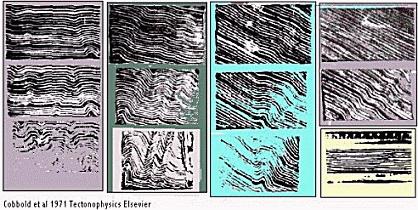 |
| KINK-BANDS AND ANISOTROPY
A rock usually deformed and metamorphosed with distinct planes, either discrete or nearly so. The response to applied stress on such a rock is different in different directions and depends on the shear as well as compression modulus which itself depends on the angle between applied stress and anisotropy planes and the degree of anisotropy. In contrast an isotropic material has the same modulii of shear and compression in all directions. The figure that accompanies this text is after Cobbold et al. 1971 who investigated experimentally Biot's theory of folding in laminated media. The interlayer slip and anisotroy are maximum to a layer parallel and layer normal shortening, but progressively decrease on applied stress changing its orientation from these two extreme situations. If the compression is layer parallel and interlayer slip not hampered, ideal conjugate kink bands are formed. If the interlayer slip gets hampered on account of lack of layer continuity or bounding material does not allow slip, the anisotropy is reduced and sinusoidal folds are formed in preference. If the compression applied is at angle to the layering, the anisotropy decreases (i.e. N and Q are not at variance but come pretty close to eachother so that their ratio is not too great), then single kink-bands are formed in preference to conjugate, other conditions having been met with. Under layer normal conditions, again the anisotropy is high and extensional kink-bands (normal) result as also other structures under low slip such as internal boudinage. The four sets of figures show how the anisotropy is under four idealised conditions chose by Cobbold, Cosgrove and Summers. This concept given by Biot(1965) but considerably developed by Cobbold et al. (1971). They considered the average rheologic properties of the rock composing the multilayered complex rather than the individual properties of each layer as done by Ramberg. This was extension of the theoretical analysis put forward by Biot in 1965 but supported by model analogue experiments using materials such as soft and hard plasticene. Biot had suggested that the anisotropy is highest when N and Q the compressive and shear moduli are widely different. That is the anisotropy is high if N>>Q and N<<Q but least when N=Q which occurs when the applied stress is at 45? to the planes of anisotropy. They found that two ratios governed the formation of structures in homogeneous anisotropic material, one of these being the ratio M/L or the ratio of compressive to shearing stress modulus and the other P/L ratio which is non-dimensional and indicates critical stress difference. M/L is plotted on the abscissa and P/L on the ordinate constructed at (M/L)/2 value. The ordinate at zero M/L indicates the initial stress. Three fields could be noticed in the accompanying diagram which indicate three different types of instabilities in a multilayered complex consisting of statistically homogeneous anisotropic material. In case of type 1 instability the ratio M/L exceeds 0.5 and the ratio P/L exceeds unity. The structures formed under this type of instability are usually sinusoidal folds. If M/L ratio is less than 0.5 and P/L ratio less than unity but greater than 4M/L(1-M/L), then the complex has high anisotropy and the structures developed are conjugate kink-bands, box folds, single kink-bands or chevron folds or mitre folds. These are known as type 2 instability structures. If M/L ratio is less than 0.5 and P/L ratio greater than unity then type 3 instability is said to develop producing structures intermediate between conjugate kink-bands and sinusoidal folds. Thus Cobbold et al.(1971) have shown that in homogeneous anisotropic media, there are two ends of a spectrum one of which represents material of high anisotropy and in which conjugate kink-bands are developed and at the other end in material of low anisotropy, sinusoidal folds are developed.
Cobbold et al. substantiated their conclusions by means of model analogue experiments. They found that when flakes of plasticene were lubricated with graphite powder, sinusoidal folds developed since the material was of low anisotropy on account of the absence of continuous layers which could allow interlayer slip. On the other hand when they used continuous plasticene layers lubricated with graphite powder, they found that conjugate kink-bands developed(Left side A of experimental photographs here). When petroleum jelly was used instead of graphite powder as the lubricant, structures intermediate between conjugate kink-bands and sinusoidal folds developed. The field example of such structures could be found in these pages in this account. They also found that as long as the compression to the model was applied to within 30° of the layering, both the sets of conjugate kink-bands(see B and C in fig) developed. But when the compression was applied at an angle of 30both the sets of conjugate kink-bands to layering, only one set of kink-bands developed (D top two in fig). They also found that when the compression was applied perpendicular to the layers, normal conjugate kink-bands developed in preference to reverse kink-bands (D in fig). In normal kink-bands, there is decrease in the thickness of the layers within the kinked zone on account of extension parallel to layers rather than shortening. Cobbold in 1976 carried out experiments on the internal buckling of a multilayer at an induced deflection and the sequence of his model experiments are shown here with a field example to support the study.
|